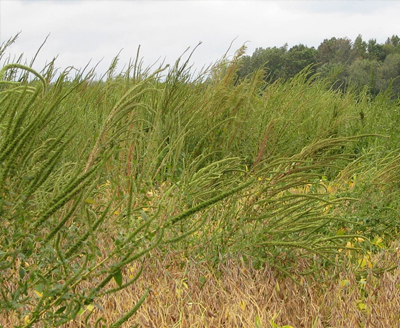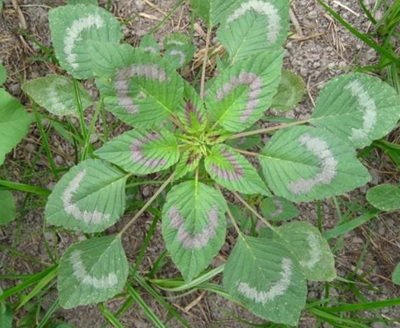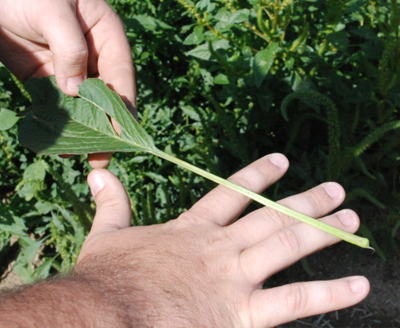
- Identification of Palmer amaranth is critical in controlling such a problematic, rapid growing weed species.
- Control Palmer amaranth can be difficult because of its rapid growth rate and it has evolved resistance to several herbicide sites of action.
- Starting the season off clean with multiple effective MOA’s followed by early postemergence sprays with an overlaying residual will provide effective control.
Palmer amaranth is a pigweed species that can resemble waterhemp in the seedling stage. It is a dioecious weed species, similar to waterhemp, which allows for increased species diversity and potential for rapid development of herbicide resistant biotypes if not managed correctly. A single Palmer amaranth plant produces as many as 500,000 seeds when left uncontrolled in a non-competitive environment. Palmer amaranth seed is small and has the potential to move very easily on tillage implements, planters, combines, and many migratory bird species. Lastly, Palmer amaranth is an early emerging weed and emerges for a rather long period of time (late April through mid-September), as well as an aggressive growing weed. Under the right conditions, Palmer amaranth can grow 2 inches per day.
Weed identification is a critical component to successful control of the target weed. If misidentified, this may result in partial control. Palmer amaranth has a distinctly long petiole, the plant structure that connects the leaf blade to the plant stem, usually as long as the leaf blade or in some cases longer (Fig. 3). The leaf blade is more egg shaped and not near as lancelet like common waterhemp leaves. Sometimes there is a short hair at the tip of the leaf blade; also, a chevron pattern or watermark may be present on the leaf surface (Fig. 2). The growth of the apical meristem in Palmer amaranth is comparable to a poinsettia, resulting in more leaf area (Fig. 2). The seed head of a Palmer amaranth plant is distinctly different from any of the amaranth species, with a seed head that can reach lengths of 2-3 feet. Seed heads of a female Palmer amaranth plant are very prickly (Fig. 1). During reproductive stages, these female plants will also produce spiny bracts on the main stem where the leaf petioles attach.
Palmer amaranth control in soybeans can be difficult for a few reasons, 1: it’s extreme growth rate reduces the length of time a herbicide provides effective control and 2: it has evolved resistance to glyphosate (group 9), PPO-inhibiting herbicides (group 14) like fomesafen (Flexstar®) and lactofen (Cobra®), and ALS inhibitors (group 2) such as imazethapyr (Pursuit®) and Photosystem II inhibitors (group 5) like atrazine. In a dicamba- resistant soybean system, Xtendimax®, FeXapan™ and Engenia® all provide excellent control of Palmer amaranth. In a glufosinate-resistant soybean system, Liberty® provides effective control of Palmer amaranth. Regardless of system, starting clean with preemergence soil-applied residuals with multiple effective modes of action (MOA) followed by an early postemergence spray at full labeled rates including an overlaying residual such as group 15 herbicides (Dual Magnum®, Warrant® or Outlook®).
Crop scouting and being able to detect a problematic weed species like Palmer amaranth early are crucial to a successful control. Utilizing effective MOA’s followed by timely spray applications are important to keep this weed under control. Research shows that harvesting the weediest fields last can help prevent the spread of seed from place to place. Lastly, consider a cover crop that when terminated creates a mat of residue that will allow less sunlight to the soil surface minimizing weed seed germination.


Image 1: Seed heads of Palmer amaranth can reach lengths of up to 3 feet. “Source: Dr. Christy Sprague, Michigan State University”
Image 2: Poinsettia-like apical meristem with chevron patterned watermark (not always visible).
Image 3: Leaf petiole is longer than the leaf blade.